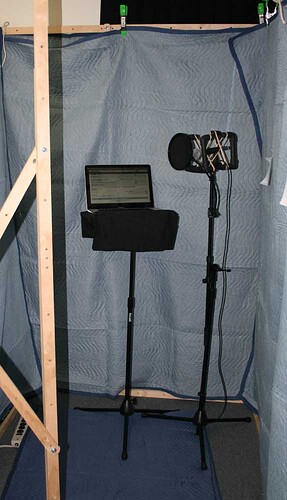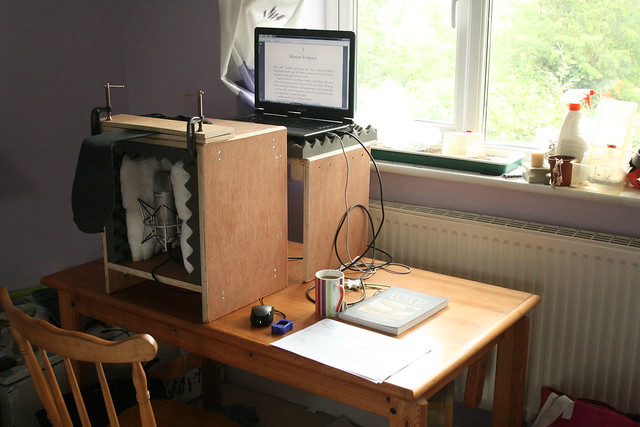My spoken vocal recorded via Samson CO1U usb mic sound kind of tinny and lack a crisp, studio feel. What is the best way to fill out overall tone of recording to give it a quality sound?? Reverb, EQ?? any suggestions for a noob?!?! Thanks!
Post some.
Be using Audacity 1.3, Not 1.2. If you’re in Audacity 1.2, we’re going to chase up to 1.3.13, anyway.
http://audacityteam.org/download/
Reduce a sample voice segment to mono if it isn’t already. Tracks > Stereo Tracks to Mono. Cut the work down to about four or five seconds.
File > Export > FLAC.
Post here using Upload Attachment at the bottom of this dialog window.
Not everybody can be Don Pardo or Don LaFontaine. For one thing, to be a professional announcer, you have to change your name to “Don.”
Koz
Often the problem is also with the “recording studio”. Echo’s can kill the show. Mic placement can also have some influence. So does the way you speak/sing. Even the way you breathe can change the way your voice sounds. And of course, like Koz said, not everyone has a radio-like deep sounding voice like some gifted persons do…
Without hearing a sample it’s hard to give advices…
The Samson is a good mic for spoken word recordings. Many folks at Librivox use them and produce very fine recordings (though some are now using Blue Yeti - can’t see the point myself - it’s still a USB mic with all of the same inherent problems). The mic does have its faults, but generating a good tone should not be one of them (I use one regularly - they are very cheap for the sound they produce!).
As has been mentioned above room treatment is very very important. To get that radio-announcer presence you need to almost completely eliminate room reverb. Spoken voice studios are much more “dead” than studios for music. You can make yourself a little microphone shield that cuts out room reverb into the back and sides of the mic - google for Harlan Hogan’s Porta Booth and you’ll get the idea. Most folks make their own. Here’s mine:
http://www.flickr.com/photos/clivecatterall/
It’s even set up to use the Samson!
Once you control the room echo you need to experiment with mic distance and direction. Generally you will probably want to record speaking directly at the mic or very slightly above or below the capsule. If you do longform voicework a pop filter is great to help you maintain a consistent head position from session to session. It helps to match voice tone when editing.
Radio announcers often have quite a bit of compression on the mic, which can alter the sound quite a bit. A good radio VO guy will have super breath control as well. Voice technique helps a lot, as does posture. Some VO artists stand to perform, or sit on a barstool rather than a chair.
I agree that some VO artists seem to be born with it, but a lot of it can be learned.
Clive
Here’s mine:
Design details?
I had to do a standup booth for multi-voices, so mine was a bit more elaborate.
I had to come up with a shock mount after the stores closed…
http://www.kozco.com/tech/pvcShockMount/shockmount.html
Those rubber bands are from the United States Postal Service.
Koz
The UK postal service (“Royal Mail”)" uses red ones which people find other uses for …
… their myriad functions, including tie-dying clothes, extending the waistbands of trousers, childproofing just about anything, and, of course, firing paper pellets across the classroom. There are, however, limits to their uses, as one enthusiast learned when she earnestly posted the question “Can you use an elastic band to neuter your cat?” to an online messageboard. The answer’s no.
The box itself is made from 3/4" plywood. The corners were sealed inside with silicone, and the back, roof and sides are lined with 2" thick acoustic foam. This was not enough to kill the internal reflections in the box, so I added a couple of 6’ lengths of polyester hollow fibre from an old duvet packed in around the sides and back. That did the trick. The box floor is raised so that the capsule is just below mouth height when sitting at a hard chair in front of my desk. The inside dimensions were chosen to allow enough room around the microphone for acoustic packing and to allow a small amount of mic movement. The microphone is held in a desk stand and shockmount.
The pop filter frame is made from 16 gauge galvanised steel tensioning wire for chainlink fencing (I had some around) and a child’s lycra stocking is stretched over it (the other leg was laddered). The pop filter is 8" from the mic front. The clamp for the pop filter needs improvement - it’s a bit of an afterthought and uses two small G-clamps. I can do something better and neater that will allow the computer stand to properly stack on top.
I have uploaded another picture of the recording set-up.
You can see the laptop stand behind the microphone box. It is at just the right height to read from the screen when speaking into the microphne. The laptop sits on another block of pyramid foam to stop fan noise transmission into the desk, and to absorb fan noise projected down. The box cuts out direct transmission of fan noise and road noise, and the recording is done in a furnished and carpeted room, so noise has to be reflected off several soft surfaces before it finds a way past my shoulder and into the front of the mic. I did experiment with a large acoustic screen positioned behine me so that even more reflected sound could be cut out, but it didn’t make any measurable difference, so I don’t bother. (I was pleased, as it was a pain to put up and take down for each session)
The laptop stand is sized so that it will stack on top of the microphone box after a recording session and the whole lot can be pushed to one side on the desk when I have to get on with other paid work.
On the desk you can see a blue dog clicker that I use for marking mistakes, and a cordless mouse that I hold in my lap during recording so I can scroll the text up and down on the PDF reader. This last bit is surprisingly important - cable noise moving across the desk is readily transmitted into the mic - with this set-up I can avoid touching the desk at all during recording .
I do sit when I record, but I sit at the front of a hard chair so my knees can be lower than my hips. This allow me to still breathe from the diaphragm in the same way as I would when standing. Standing is better for voice production, but sitting makes it easier to control the mouth to microphone distance.
.
Clive

